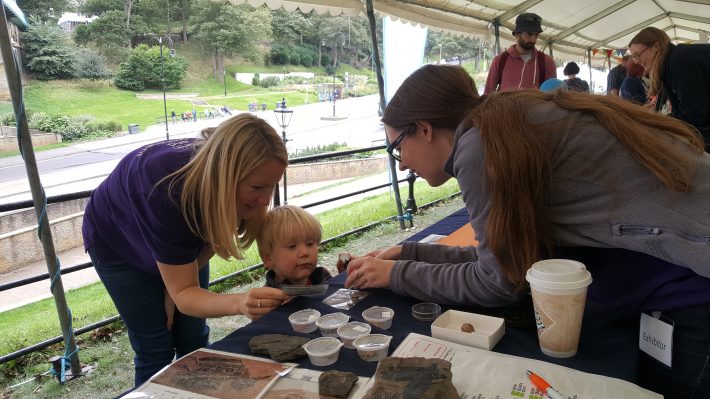Fossil poo at the Yorkshire Fossil Festival
I was delighted to be awarded funding from the BES Regional Funding Scheme to attend the Yorkshire Fossil Festival in Scarborough.

As a palaeobotanist, I am often asked what is the point of studying fossils and why are they important (apart from dinosaurs who are exempt– apparently they are particularly cool or so several of the children told me). Although most people tend to think that fossils are interesting, the link between modern ecology and palaeoecology is often unclear. For this reason, I was particularly keen to highlight how modern ecology can inform our understanding of palaeoecology and vice versa.
Funding from BES made it possible for me to contribution to the School of Earth and Environment, University of Leeds, stall at the festival. Together we presented a suite of games, posters, and fossils to show the importance of understanding the links between palaeoecology, palaeobiology and climate change, particularly for climate modeling which was presented by members of the Past Earth Network.
At the BES end of the stall, the poo and coprolite (fossil poo) game proved particularly popular, especially on the schools day when we spoke to children from around Scarborough. Children (and adults) were asked to match the disturbingly life-like model poo to the animal photos and then figure out what type of diet an animal had in order to leave behind particular types of coprolite. This led to numerous fantastic discussions – it turns out poo is a great conversation starter– and many people commented on how pretty some of the polished coprolites are, showing that you can, if you really want to, polish a turd!
The other part of the display highlighted the role fossil plants play in interpreting the environment. We showed fabulous local examples of Carboniferous (~300 million years ago) coal swamp plants and Jurassic (~201 million years ago) forest plants and chatted about how understanding fossil plants can help us to understand environmental change on different timescales. I explained how understanding ecological responses to past environmental change can help us understand how modern ecosystems may respond to near-future climate change. Some of the children were amazed that plants could be fossils too – perhaps a few budding palaeobotanists in the audience.
The final topic looked at plant–animal interactions in modern ecology and the fossil record, with a focus on pollination. Photographs of fossil pollinators were used to illustrate pollinators in the fossil record and highlight the role they played in pollination. The BES Pollinator Top Trump game was also used to highlight the wide range of animal pollinators we have in modern ecosystems. Being part of the group who developed Pollinator Top Trump through the BES public engagement programme earlier this year, I was delighted to finally see it in action and being enjoyed by all.
Over 400 people stopped by the stand to chat about fossil plants and poo. This provided me with a fantastic opportunity to talk to visitors about the importance of fossil plants and the important links between palaeoecology and modern ecology. It was a thoroughly enjoyable (if exhausting) experience, and I am grateful to both my University of Leeds colleagues for making the festival incredibly enjoyable and to the BES for providing funding to attend and contribute to a stand at this fantastic event.
Like what we stand for?
Support our mission and help develop the next generation of ecologists by donating to the British Ecological Society.